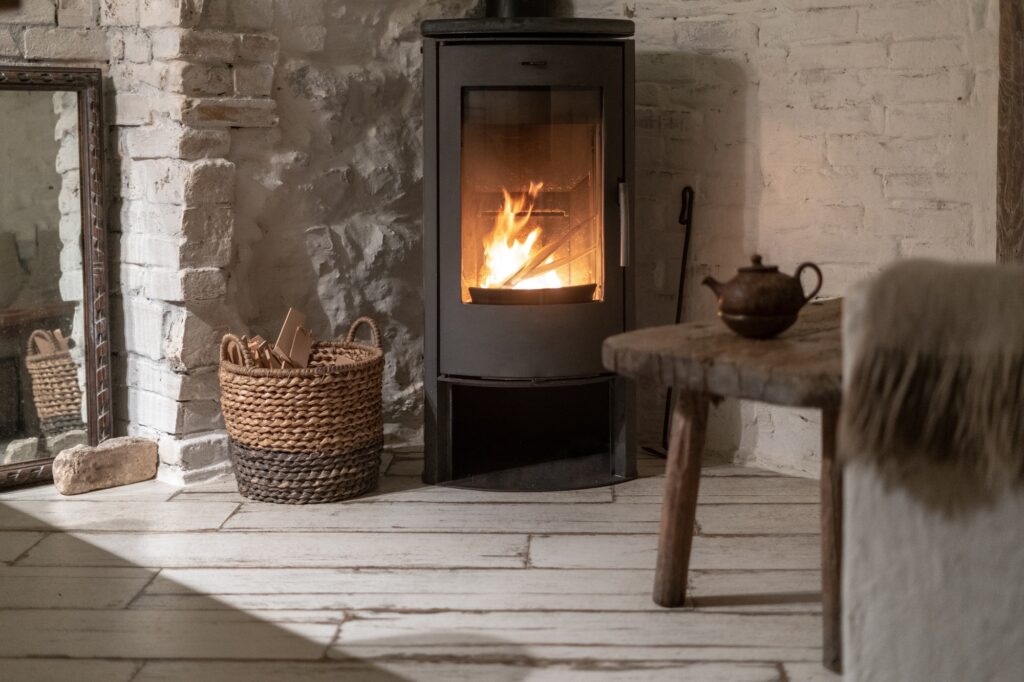
Finding the best wood stoves under $2,000 can be a challenge. The best wood stove has to be one that is suited to your purpose, your way of life and your budget. There are many wood stoves out there on the market and they have a huge difference in price tag. So, it can be hard to find a stove that fits your needs but does not break the bank.
You have to make sure that you pick something that is of good quality and which will last for many years. Here is our list of highest-quality stoves that won’t burn holes in your wallet.
Wood stoves are a lot of fun to use, but they can also be a bit of a pain especially if you choose the wrong one.
How you decide on wood stove types depends a lot on your needs, budget and plentiful of other factors you need to consider. Many of these stoves are quite capable and heat homes quite well but are not necessarily the best choice for your usage. So, use this guide I’ve put together to help you select the perfect wood-burning stove under $2,000 for your house.
Table of Contents
Wood Stove Purchasing Guide
1. Wood Stove Size (BTU output)
When purchasing a wood stove, it is important to consider the heat output. This will help you determine the size of stove you need and how much heat it will produce. One of the best things to do is look at the BTU output and the effective heating area for room space. The BTU is the amount of heat a stove can produce in one hour, measured in British Thermal Units (BTU).
As a general rule of thumb, you will need a minimum of 30-35 BTUs per square foot. Of course, this can change depending on your region and other variables such as your ceiling height, open staircase or wall insulations. You do not want to over or undersize your stove and do take into account any heat escapement around your rooms. So, if you are dwelling in a 500 square foot room and you want to keep the temperature at 68F, you will need a minimum of 15,000-17,500 BTUs.
2. Wood Stove Efficiency and EPA Regulations
The efficiency of a wood stove is measured by the percentage of heat that is transferred from the burning wood to the room. A typical wood stove has an efficiency rating of about 70 percent, which means that 70% of the heat produced by the burning wood is transferred to the room. The remaining 30 percent is lost up the chimney.
That said, you would want to cross-check with the EPA database for a highly efficient wood stove and be careful not to land yourself with old new stoves with smoke emissions of more than 2.0 g/h.
3. Wood Stove Material
There are a few materials that are commonly used that I think you should know.
Cast iron is one of the most popular materials, as it is durable and efficient in heat retention. On top of its classic appealing design, this type of wood stove can last for many years. One drawback with cast iron is the possibility of rust or oxidation, which can compromise the longevity of the stove.
Steel on the other hand conducts and heat up your room faster but cools down at a faster rate than cast iron. But that doesn’t mean it is more inferior. In fact, steel stoves are just as good.
Soapstone beats cast iron and any other material at heat retention. It also provides thermal comfort since the properties of the material absorbs heat and gradually radiates out to your surrounding. Plus, you’ll use less firewood, meaning fewer trips to the woodpile.
4. Wood Stove Type (Catalytic or Non-Catalytic)
This is the part where you’ve got to understand the basics of how catalytic and non-catalytic wood stove works.
Non-catalytic also known as secondary burners make use of the combustible gases from the primary fuel, which is your log, to fuel itself for the second burn. This reduces the smoke emissions solely produced by the primary burn and increases the efficiency compared to the traditional stove that directly releases the creosote through the vents.
Catalytic stoves use a special catalyst combustor to help accelerate the burn process of the remaining particulates and gases, giving them a more complete burn and much cleaner gas. The main advantage of using a catalytic stove is that they produce less creosote and less smoke, making them ideal if you do not like to babysit your stove and constantly refuel them.
Here is the side by side comparison between them to get a clearer picture:
| Non-catalytic | Catalytic | |
| Burn Time | Good burn time (Up to 14 hours) | Very long burn time (Up to 40 hours) |
| Maintenance | Yearly | Catalyst combustor (1.5 months) Replacement of catalyst combustor required every 5-6 years Requires regular inspection |
| Average Efficiency | 78% | 71% |
| Ease of use | Simple | Require some knowledge |
| Fuel consumption | Higher | Lower |
5. Burn Time
Understanding what burn time means is also crucial. Besides the size of the fire box, amount of air inflow and type of wood stove, how high or how low you burn also affects the burn time, along with other factors like wood type and moisture. So, as you go through the operation manual to read off the burn time, that burn time essentially tells you the maximum burn time of log under the Low Heating Value condition. This also means you do not get maximum/high heat output throughout the burn time.
Best Indoor Wood Stove Under $2,000
1. Osburn OB01700 (Best wood burning stove)
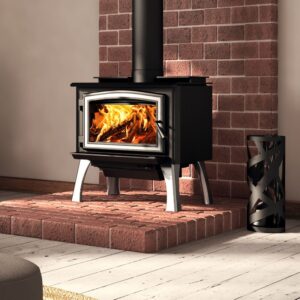
The Osburn OB01700 have a number of positive features that make it stand out from the crowd. Let’s take a look at some of these benefits. This non-catalytic Wood Stove is a high-quality, EPA-certified stove that provides efficient heat and beautiful flames. The stove is made with welded steel and features a cast iron door with a large viewing window. It also has a powerful blower to circulate heat throughout your 500ft-1800ft home with ease.
Osburn has a long and successful track record for manufacturing wood stoves since 1979. Their products are known for their quality, durability, and efficiency will heat your home reliably for years to come.
They have stunningly low smoke and creosote emissions of 1.26g/h which means the stove provides a more complete burn and less wood usage from its secondary burn.
With the decently sized fire box of 1.9 cubic feet, it is able to supply a max heat output of 65,000 BTU/h. What I personally like most about the stove is the front lid tray design that manages to catch ashes when I open the door.
However, do take note that this is not approved for a prefab home and the customization and accessories may come a little pricey.
Overall, an awesome stove and I’m a huge fan! See price of Osburn 1700 on HVACdirect here.
2. Drolet Escape 1800
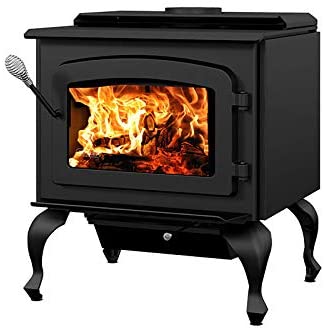
The droplet escape 1800 wood stove is another great choice for those who are looking for an efficient and reliable way to heat their home. This stove is made with high-quality carbon steel and a pretty brushed nickel door overlay. It also has a 2.4 cubic feet large fire box that can accommodate logs up to 20 inches in length.
One of the things that we like about this stove is its easy assembly. It does not take a lot of time and effort to put it together to heat an area of 500-2100 square feet.
With proper air control, you can have an all-night burn and when you wake up, the coal will still be smoldering ready to reignite another log. Easy reloading, easy reigniting, and easy clean-up, are the kind of qualities that we all look for in our stoves.
This wonderful indoor wood stove can get you a max heat output of 75,000 BTU/h. Once again, EPA certified stove with a burn time of up to 8 hours. Not forgetting the super silent blower fan and thermal comfort it provides is just another superb feature that makes this stove a great choice.
For the amount of heat it radiates, it is worth every penny of your investment. See price of Drolet Escape 1800 on Amazon here.
3. Timberwolf 2100-1
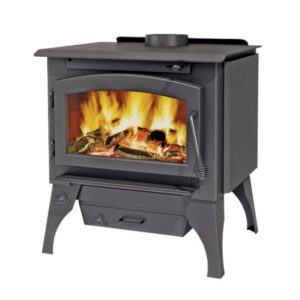
The Timberwolf 2100-1 wood stove is a high-efficiency EPA-certified stove that burns clean and hot, emitting 1.57g/h of smoke. It has a large fire box that can fit 18″ logs and a decent burn time of 6 solid hours. The 2100-1 also features a cast iron door with side heat shields provided, and a really large viewing window to keep an eye on the fire.
This compact little guy here looks elegant and fiery at the same time, supplying a maximum of 52,000 BTU/hr that can effectively heat up to 1,500 square feet. However, this non-catalytic wood burner is not a mobile home-approved model and it requires higher clearance than the few options above. Just be aware that you’ve got to be gentle when refueling to avoid damaging the fire shields.
With such high heat production, this is definitely a great value for the money. See price of Timberwolf 2100-1 on HVACdirect here.
3. Ventis HES140
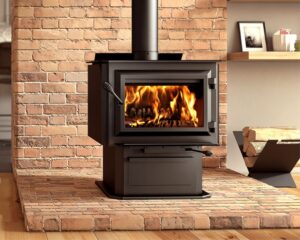
The Ventis HES140 pedestal wood stove is a top-of-the-line appliance that is perfect for those who want to heat their homes of 250-1,200 square feet. The HES140 has an efficiency rating of 78% and is extremely suitable for small living spaces even in mobile homes. There is no doubt Ventis HES140 will be able to keep you warm throughout the winter.
This 45,000 BTU/hr EPA-certified stove does not burn very long due to the fire box size of 1.4 Cubic feet and also produces a slightly higher emission of 1.8g/h but they offer a limited lifetime warranty to their stove. So, you can have peace of mind on their product.
See price of Ventis HES140 on HVACdirect here.
5. US Stove (Most classic)
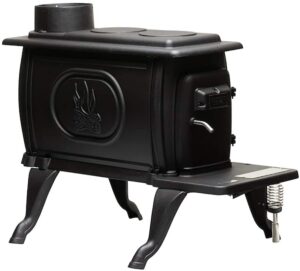
The classic look of the US stove US1269E has such high appeal to me. It has the perfect rustic touch that is made out of cast iron. This stove is extremely affordable and throws out 54,000 BTU/hr to 900 square feet. Despite its small 1.2 cubic feet fire box, it can burn up to 5 hours and fit 19-inch log. If you are looking for a budget burner, this is one of the best options out there. With its classic lines, it will bring a sense of comfort to your home.
There might be a couple of reviews with smoke leaking and such, but we have had no issues whatsoever if the damper is set to the ideal position and with proper flue maintenance. The creosote buildup is one of the causes of smoke backflow and with a basic understanding, it should not be an issue. You could also seal off the seams with caulking material if you are worried about smoke leaks. But, this tiny wood stove gives you the best heat output for the amount that you are going to spend.
See price of US Stove on Amazon here.
Final Note:
Of all the home heating options, wood burning stove has the cheapest operational cost. The wood stove installation cost is also justifiable in the long run. But make sure to practice safe burning. You should place one fire extinguisher near the indoor stove and install a calibrated carbon monoxide detector to protect yourself.
So, this list completes the top 5 most affordable and high-quality non-catalytic stoves that I have come across. Other than wood stoves, you might also want to open your options to pellet stove. I hope this information helps you in some way, so you can make an informed decision before you go for any of the options.
Happy snuggling and stay warm!

